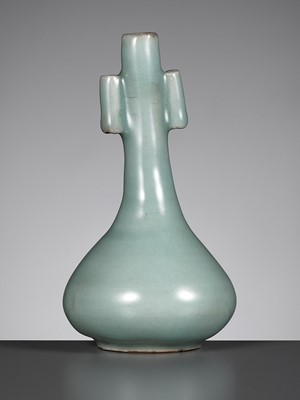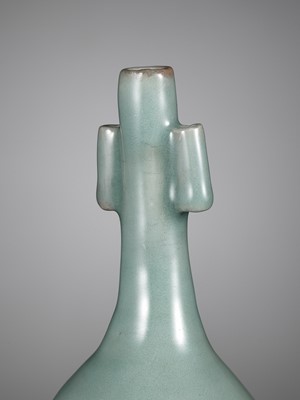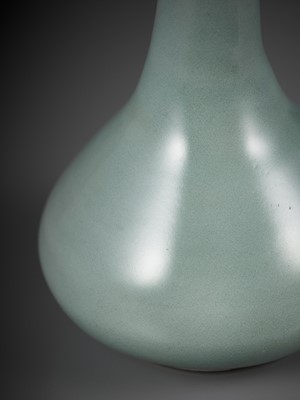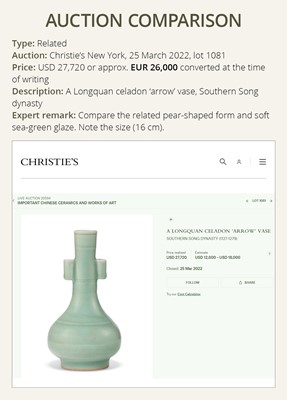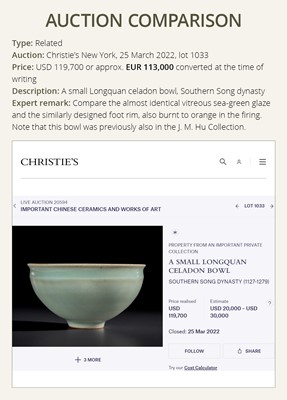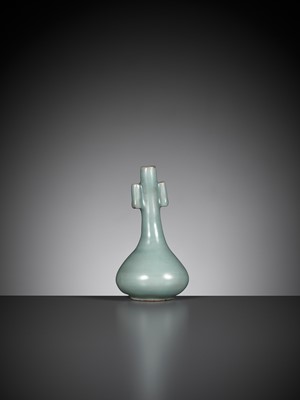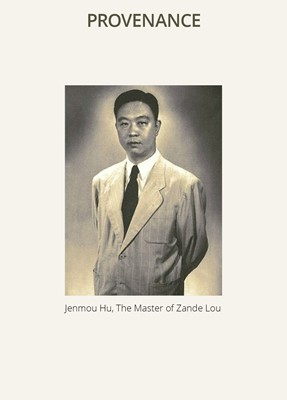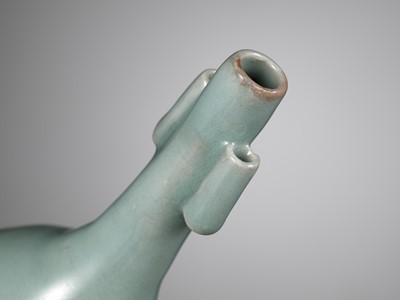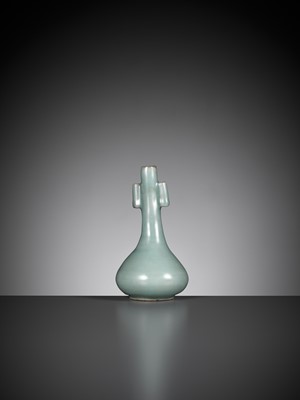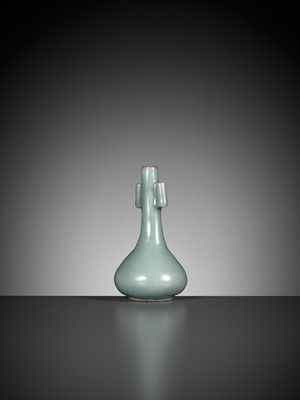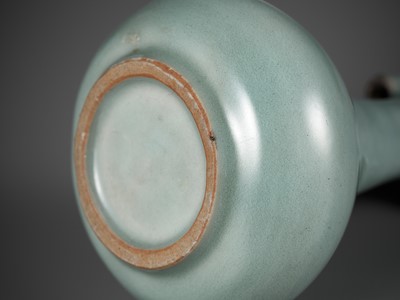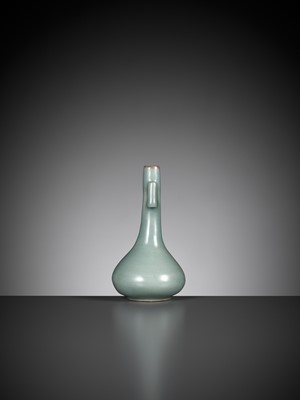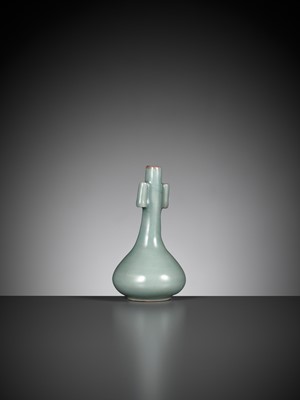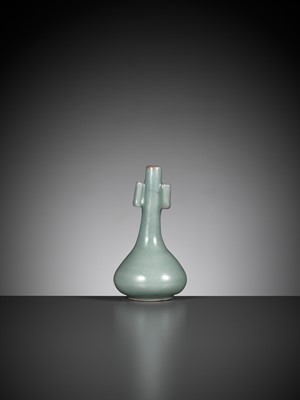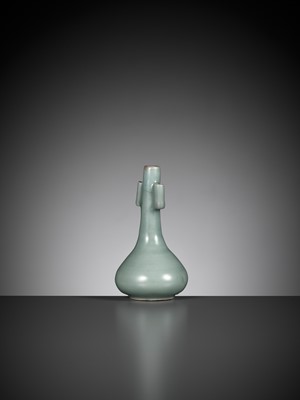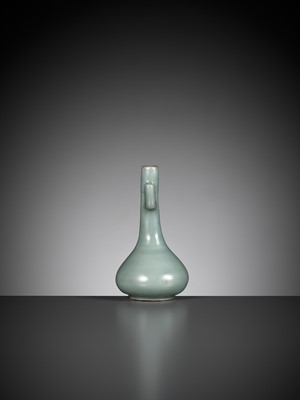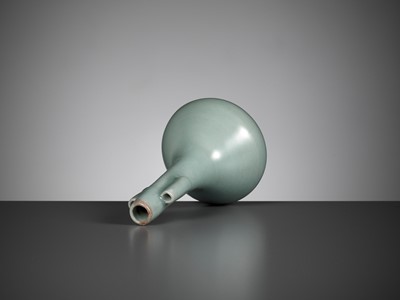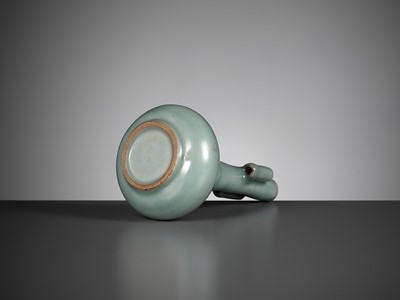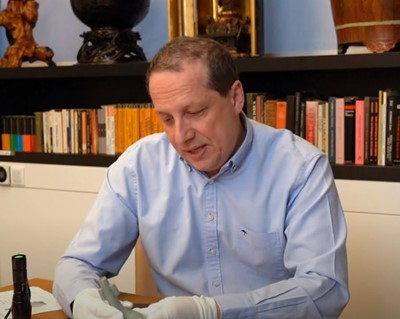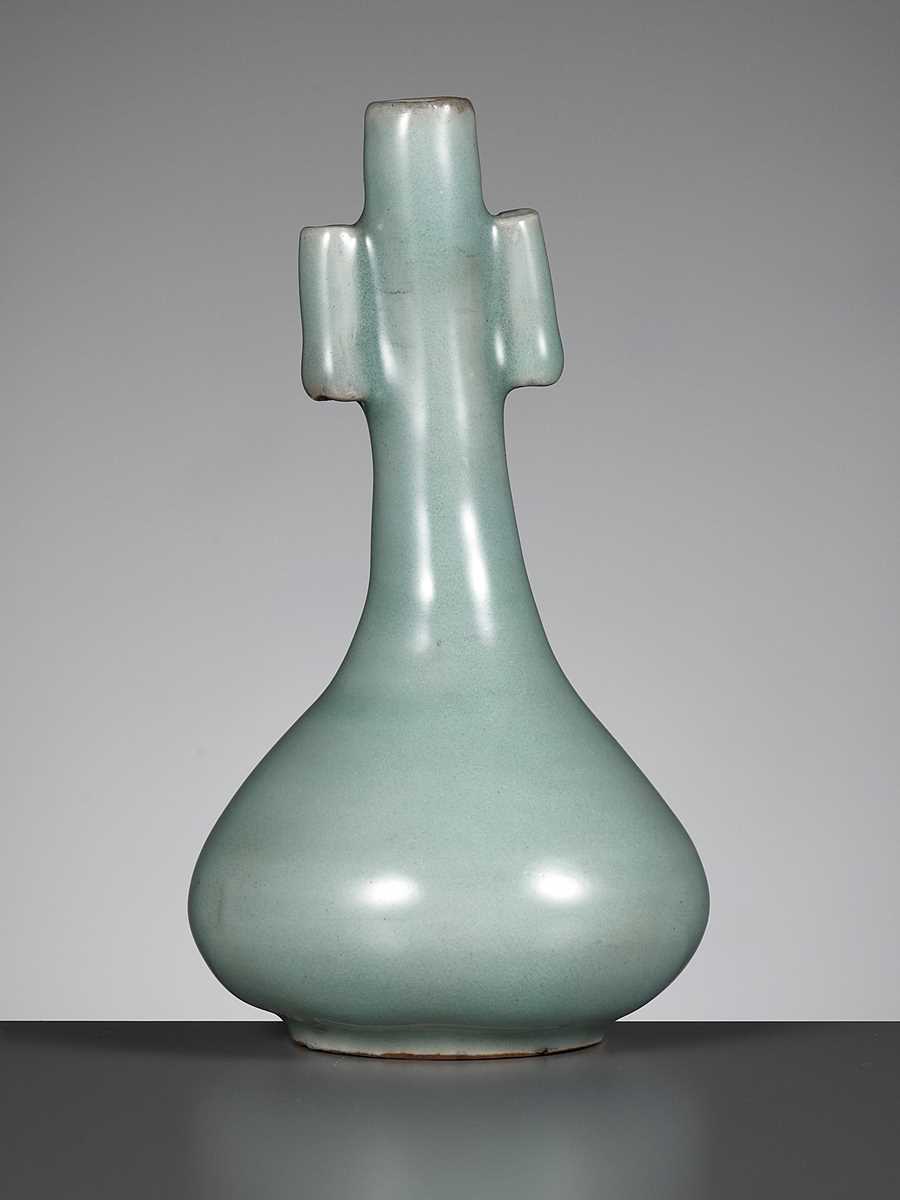9th Mar, 2023 13:00
TWO-DAY AUCTION - Fine Chinese Art / 中國藝術集珍 / Buddhism & Hinduism
77
A LONGQUAN CELADON ARROW VASE, TOUHU, SOUTHERN SONG DYNASTY
南宋龍泉青瓷投壺
Sold for €8,450
including Buyer's Premium
China, 1127-1279. Delicately potted, the pear-shaped body supported on a short tapered foot and rising to a long slender neck flanked by a pair of tubular handles. Covered overall in a rich vitreous glaze of soft sea-green color, save for the unglazed foot rim revealing the ware burnt to orange in the firing.
Provenance: The J. M. Hu, Zande Lou Collection. Jenmou Hu (1911-1995) was arguably the most important collector of Chinese ceramics in the last century. In both his personal collection and in his bequests to cultural institutions, J. M. Hu stood as a model of the modern scholar-collector. The eldest son of the influential banker Hu Chun, he was raised in an elegant private residence amongst his many stepbrothers and stepsisters. In keeping with tradition, he was given a rigorous background in the Chinese classics, supplemented by a Western-style education. He first encountered Chinese ceramics during his student years, when he purchased a nineteenth-century brush washer for his desk. This initial foray into collecting would become emblematic of J. M. Hu’s poignant relationship with art: even amidst the upheavals of war and the evolution of his collection, the modest brush-washer stayed with him until his death in 1995. Hu’s boyhood studies within the Chinese literati tradition greatly informed his philosophical approach to life and collecting; humble and erudite, he consistently affirmed that it was the visceral connection between a collector and his acquisitions that was of essential importance. True value, in J. M. Hu’s estimation, lay far beyond monetary worth. A noted traditionalist, he went to great lengths designing wooden stands and fitted boxes to preserve and display his Chinese treasures and delighted in sharing the collection with fellow connoisseurs. For J. M. Hu, collecting was a serious, scholarly pursuit not to be taken lightly. The joy of art came with a responsibility to honor both the artist and the object. Hu often spoke of the three necessary criteria in collecting: zhen (authenticity), jing (rarity and quality), and xin (condition). Yet it was an individual’s bond with a work of art, as evidenced in J. M. Hu’s beloved brush washer, that was of fundamental significance. In handling and examining his ceramics, Hu sought that indefinable delight that could come only from the beauty of artistry. In the tradition of Chinese literati who bestowed symbolic monikers upon their studios, libraries, and collections, the name of J. M. Hu’s studio, Zande Lou, referenced the influential Lanting Xu of the famed Jin dynasty calligrapher Wang Xizhi, a text that describes Zande as a person’s inner happiness. Although J. M. Hu intended the meaning of Zande to express this fleeting happiness, which he experienced as a collector when examining an object, the word has also come to be interpreted as the inherently transitory nature of collecting and possessing fine art. J. M. Hu’s collection of Chinese ceramics provided abundant opportunity for personal scholarship and historical investigation. As early as the 1940s, he longed for a welcoming social environment where like-minded collectors could share and discuss art and objects. Two decades later, he established the Min Chiu Society in Hong Kong alongside fellow collectors K.P. Chen and J.S. Lee. A noted cultural philanthropist, J. M. Hu gifted substantial groupings from his collection to the Shanghai Museum in 1950 and again in 1989. Many of these objects remain on view in the museum’s Zande Lou Gallery. To this day, J. M. Hu remains a celebrated figure amongst collectors of Chinese art.
Condition: Excellent condition with expected old wear and minor firing irregularities, including glaze recesses and other minuscule glaze faults. The neck is slightly leaning. The unglazed areas of the ware burnt to orange in the firing.
Weight: 149.2 g
Dimensions: Height 12.3 cm
The form of this vase is based on arrow vases, or touhu, the primary accessory of a drinking game which involved throwing all of one's arrows into the mouth of the vessel. The loser was assessed a penalty drink for every errant throw. This game had been popular among elite men and women from the Spring and Autumn period (770-476 BC) onwards. In line with emerging trends of antiquarianism and archaism, the game was revived during the Song dynasty and touhu vases, made in various materials including bronze, cloisonné, and ceramic, remained popular throughout the Ming dynasty and later.
Elaborate rituals and intricate rules, recorded in the Li Ji (Book of Rites), added further complexity to the game. Puzzling pitching techniques were described in the Touhu Yijie (Ceremonial Usages and Rules of Touhu), an illustrated manual written by Wang Ti (1490-1530), and these shots were given fancy names, like ‘A Pair of Dragons Enters the Sea’ when two arrows were thrown from a great height at once into the vase. The touhu game was used to practice archery, one of the essential accomplishments of a gentleman. Later in the Ming era, the game became more widespread and was played by rich merchants as well as the aristocracy and scholarly elite. A scene in the famous late Ming novel Jin Ping Mei (Plum Blossom in the Golden Vase), written in 1619, describes the wealthy merchant Ximen Qing's seduction of his concubine Panjinlian. She becomes inebriated while playing touhu on a picnic and the game leads to an amorous encounter. For a further discussion of the game see Isabelle Lee, 'Touhu: Three Millennia of the Chinese Arrow Vase and the Game of Pitch-pot', Transactions of the Oriental Ceramic Society, vol. 56, 1991-2, pp. 13-7.
Too small to actually be used in the drinking game, the present vase was probably intended to hold a single branch, a small flower, or an incense stick.
Literature comparison:
A pair of related Longquan arrow vases, of slightly larger size and with wider necks, was recovered from the tomb of the Yuan calligrapher Xian Yushu (1251-1302), see Zhang Yulan, Hangzhoushi faxian Yuandai Xian Yushu mu, Wenwu, 1990:9, page 24, figures 11-12. A similar vase was included in the exhibition, The Scholar as Collector: Chinese Art at Yale, Yale University Art Gallery and China Institute in America, New York, 2004, page 18, figure 8.
Auction result comparison:
Type: Related
Auction: Christie’s New York, 25 March 2022, lot 1081
Price: USD 27,720 or approx. EUR 26,000 converted at the time of writing
Description: A Longquan celadon ‘arrow’ vase, Southern Song dynasty
Expert remark: Compare the related pear-shaped form and soft sea-green glaze. Note the size (16 cm).
Auction result comparison:
Type: Related
Auction: Christie’s New York, 25 March 2022, lot 1033
Price: USD 119,700 or approx. EUR 113,000 converted at the time of writing
Description: A small Longquan celadon bowl, Southern Song dynasty
Expert remark: Compare the almost identical vitreous sea-green glaze and the similarly designed foot rim, also burnt to orange in the firing. Note that this bowl was previously also in the J. M. Hu Collection.
南宋龍泉青瓷投壺
中國,1127-1279年。胎體緊密,細長頸,頸部有對稱貫耳,豐腹下垂,圈足。通體覆蓋著柔和的青釉,足緣露胎,在燒製中成橙色。
來源:胡惠春暫得樓收藏。胡惠春(1911-1995),別名胡仁牧,可以說是上個世紀最重要的中國陶瓷收藏家之,是現代學者收藏家的典範。作為有影響力的銀行家胡筆江的長子,他在一所私人住宅中與眾多兄弟和姐妹一起長大。秉承傳統,他接受了嚴謹的中國經典背景,並輔以西式教育。他第一次接觸中國陶瓷是在他的學生時代,當時他為他的辦公桌買了一個十九世紀的筆洗。最初對收藏的嘗試成為胡惠春與藝術聯繫,即使戰爭動盪,他的筆洗一直陪伴著他直到 1995 年去世。傳統極大地影響了他對生活和收藏的哲學態度; 他謙遜而博學,始終堅信收藏家與其收藏品之間的內在聯繫至關重要。 在胡惠春看來,藏品真正的價值遠遠超出其金錢價值。他是一位出名的傳統主義者,不遺餘力地設計木架和合適的盒子來保存和展示他的中國收藏,並樂於與其他鑑賞家分享這些收藏。對於胡惠春來說,收藏是一項嚴肅的學術追求,不容輕視。 藝術的樂趣伴隨著尊重藝術家和藏品的責任。胡惠春經常談到收藏的三個必要標準:真(真實性)、精(稀有性和質量)和心(條件)。然而,正如胡惠春鍾愛的筆洗所證明的那樣,個人與藝術品的聯繫具有根本意義。在處理和檢查他的陶瓷時,胡先生追求那種來自藝術之美的無法形容的愉悅。按照中國文人為書房、圖書館和藏品命名的傳統,互惠春為其收藏取名暫得樓,出自《蘭亭序》,指任何珍藏都不可能永遠擁有,足見胡氏心境之豁達。胡惠春的中國陶瓷收藏為個人學術研究和歷史調查提供了豐富的機會。早在二十世紀四十年代,他就渴望有一個溫馨的社交環境,志同道合的收藏家可以在這里分享和討論藝術和物品。二十年後,他與其他收藏家 K.P. 在香港成立了敏求學社。作為著名的文化慈善家,胡惠春於1950至1989年間,共捐了近360件瓷器予上海博物館,這些重要的瓷器藏品至今仍然開放予公眾參觀,為人津津樂道。
品相:狀況極佳,有磨損和輕微的燒製不規則性,包括釉面凹陷和其他微小的釉面缺陷。頸部微微傾斜,器皿的未上釉區域在燒製中被燒成橙色。
重量:149.2 克
尺寸:高 12.3 厘米
投壺最早應是東週與春秋左近出現,源流本為“射禮”。最早投壺不是遊戲,而是諸侯國間的國家禮儀。投壺成為遊戲,是戰國後期才開始的。此等遊戲,在皇家燕宴,士大夫、文人們宴飲或雅集之際,必得以“雅歌”伴“投壺”助興。其投壺技巧百出,有背向反投者,遮目盲投者,隔了屏風越投者,或各種舞蹈技藝投壺者等等,不一而足。
《禮記》中記錄的精心製定的儀式和復雜的規則。明代投壺,又有新的發展,投擲技法百有四十,這在《投壺奏矢》一書中有載。1619年著名的《金瓶梅》書中,就描寫了西門慶勾引潘金蓮的場景,其中就有投壺的遊戲。有關投壺遊戲的進一步討論,請參見 Isabelle Lee,《Touhu:Three Millennia of the Chinese Arrow Vase and the Game of Pitch-pot',Transactions of the Oriental Ceramic Society》,卷56,1991年第2冊,頁13-7。
文獻比較:
一對相近的墓中出土的龍泉投壺,飾有元代書法家鮮于樞的書法,尺寸稍小和頸部較寬,見張玉蘭,《杭州市發現元代鮮于樞墓》,文物,1990年第9期,頁24,圖11-12。一件相似的投壺曾經展於《The Scholar as Collector: Chinese Art at Yale》,耶魯大學美術館,紐約,2004年,頁18,圖8。
拍賣結果比較:
形制:相近
拍賣:紐約佳士得,2022年3月25日,lot 1081
價格:USD 27,720(相當於今日EUR 26,000)
描述:南宋龍泉青瓷投壺
專家評論:比較相近的梨形和柔和的青釉。請注意尺寸(16 厘米)。
拍賣結果比較:
形制:相近
拍賣:紐約佳士得,2022年3月25日,lot 1033
價格:USD 119,700(相當於今日EUR 113,000)
描述:南宋龍泉青瓷小碗
專家評論:比較幾乎相同的青釉,以及相似的足緣,足緣露胎,在燒製中成橙色。請注意此碗也曾是胡惠春暫得樓收藏。
China, 1127-1279. Delicately potted, the pear-shaped body supported on a short tapered foot and rising to a long slender neck flanked by a pair of tubular handles. Covered overall in a rich vitreous glaze of soft sea-green color, save for the unglazed foot rim revealing the ware burnt to orange in the firing.
Provenance: The J. M. Hu, Zande Lou Collection. Jenmou Hu (1911-1995) was arguably the most important collector of Chinese ceramics in the last century. In both his personal collection and in his bequests to cultural institutions, J. M. Hu stood as a model of the modern scholar-collector. The eldest son of the influential banker Hu Chun, he was raised in an elegant private residence amongst his many stepbrothers and stepsisters. In keeping with tradition, he was given a rigorous background in the Chinese classics, supplemented by a Western-style education. He first encountered Chinese ceramics during his student years, when he purchased a nineteenth-century brush washer for his desk. This initial foray into collecting would become emblematic of J. M. Hu’s poignant relationship with art: even amidst the upheavals of war and the evolution of his collection, the modest brush-washer stayed with him until his death in 1995. Hu’s boyhood studies within the Chinese literati tradition greatly informed his philosophical approach to life and collecting; humble and erudite, he consistently affirmed that it was the visceral connection between a collector and his acquisitions that was of essential importance. True value, in J. M. Hu’s estimation, lay far beyond monetary worth. A noted traditionalist, he went to great lengths designing wooden stands and fitted boxes to preserve and display his Chinese treasures and delighted in sharing the collection with fellow connoisseurs. For J. M. Hu, collecting was a serious, scholarly pursuit not to be taken lightly. The joy of art came with a responsibility to honor both the artist and the object. Hu often spoke of the three necessary criteria in collecting: zhen (authenticity), jing (rarity and quality), and xin (condition). Yet it was an individual’s bond with a work of art, as evidenced in J. M. Hu’s beloved brush washer, that was of fundamental significance. In handling and examining his ceramics, Hu sought that indefinable delight that could come only from the beauty of artistry. In the tradition of Chinese literati who bestowed symbolic monikers upon their studios, libraries, and collections, the name of J. M. Hu’s studio, Zande Lou, referenced the influential Lanting Xu of the famed Jin dynasty calligrapher Wang Xizhi, a text that describes Zande as a person’s inner happiness. Although J. M. Hu intended the meaning of Zande to express this fleeting happiness, which he experienced as a collector when examining an object, the word has also come to be interpreted as the inherently transitory nature of collecting and possessing fine art. J. M. Hu’s collection of Chinese ceramics provided abundant opportunity for personal scholarship and historical investigation. As early as the 1940s, he longed for a welcoming social environment where like-minded collectors could share and discuss art and objects. Two decades later, he established the Min Chiu Society in Hong Kong alongside fellow collectors K.P. Chen and J.S. Lee. A noted cultural philanthropist, J. M. Hu gifted substantial groupings from his collection to the Shanghai Museum in 1950 and again in 1989. Many of these objects remain on view in the museum’s Zande Lou Gallery. To this day, J. M. Hu remains a celebrated figure amongst collectors of Chinese art.
Condition: Excellent condition with expected old wear and minor firing irregularities, including glaze recesses and other minuscule glaze faults. The neck is slightly leaning. The unglazed areas of the ware burnt to orange in the firing.
Weight: 149.2 g
Dimensions: Height 12.3 cm
The form of this vase is based on arrow vases, or touhu, the primary accessory of a drinking game which involved throwing all of one's arrows into the mouth of the vessel. The loser was assessed a penalty drink for every errant throw. This game had been popular among elite men and women from the Spring and Autumn period (770-476 BC) onwards. In line with emerging trends of antiquarianism and archaism, the game was revived during the Song dynasty and touhu vases, made in various materials including bronze, cloisonné, and ceramic, remained popular throughout the Ming dynasty and later.
Elaborate rituals and intricate rules, recorded in the Li Ji (Book of Rites), added further complexity to the game. Puzzling pitching techniques were described in the Touhu Yijie (Ceremonial Usages and Rules of Touhu), an illustrated manual written by Wang Ti (1490-1530), and these shots were given fancy names, like ‘A Pair of Dragons Enters the Sea’ when two arrows were thrown from a great height at once into the vase. The touhu game was used to practice archery, one of the essential accomplishments of a gentleman. Later in the Ming era, the game became more widespread and was played by rich merchants as well as the aristocracy and scholarly elite. A scene in the famous late Ming novel Jin Ping Mei (Plum Blossom in the Golden Vase), written in 1619, describes the wealthy merchant Ximen Qing's seduction of his concubine Panjinlian. She becomes inebriated while playing touhu on a picnic and the game leads to an amorous encounter. For a further discussion of the game see Isabelle Lee, 'Touhu: Three Millennia of the Chinese Arrow Vase and the Game of Pitch-pot', Transactions of the Oriental Ceramic Society, vol. 56, 1991-2, pp. 13-7.
Too small to actually be used in the drinking game, the present vase was probably intended to hold a single branch, a small flower, or an incense stick.
Literature comparison:
A pair of related Longquan arrow vases, of slightly larger size and with wider necks, was recovered from the tomb of the Yuan calligrapher Xian Yushu (1251-1302), see Zhang Yulan, Hangzhoushi faxian Yuandai Xian Yushu mu, Wenwu, 1990:9, page 24, figures 11-12. A similar vase was included in the exhibition, The Scholar as Collector: Chinese Art at Yale, Yale University Art Gallery and China Institute in America, New York, 2004, page 18, figure 8.
Auction result comparison:
Type: Related
Auction: Christie’s New York, 25 March 2022, lot 1081
Price: USD 27,720 or approx. EUR 26,000 converted at the time of writing
Description: A Longquan celadon ‘arrow’ vase, Southern Song dynasty
Expert remark: Compare the related pear-shaped form and soft sea-green glaze. Note the size (16 cm).
Auction result comparison:
Type: Related
Auction: Christie’s New York, 25 March 2022, lot 1033
Price: USD 119,700 or approx. EUR 113,000 converted at the time of writing
Description: A small Longquan celadon bowl, Southern Song dynasty
Expert remark: Compare the almost identical vitreous sea-green glaze and the similarly designed foot rim, also burnt to orange in the firing. Note that this bowl was previously also in the J. M. Hu Collection.
南宋龍泉青瓷投壺
中國,1127-1279年。胎體緊密,細長頸,頸部有對稱貫耳,豐腹下垂,圈足。通體覆蓋著柔和的青釉,足緣露胎,在燒製中成橙色。
來源:胡惠春暫得樓收藏。胡惠春(1911-1995),別名胡仁牧,可以說是上個世紀最重要的中國陶瓷收藏家之,是現代學者收藏家的典範。作為有影響力的銀行家胡筆江的長子,他在一所私人住宅中與眾多兄弟和姐妹一起長大。秉承傳統,他接受了嚴謹的中國經典背景,並輔以西式教育。他第一次接觸中國陶瓷是在他的學生時代,當時他為他的辦公桌買了一個十九世紀的筆洗。最初對收藏的嘗試成為胡惠春與藝術聯繫,即使戰爭動盪,他的筆洗一直陪伴著他直到 1995 年去世。傳統極大地影響了他對生活和收藏的哲學態度; 他謙遜而博學,始終堅信收藏家與其收藏品之間的內在聯繫至關重要。 在胡惠春看來,藏品真正的價值遠遠超出其金錢價值。他是一位出名的傳統主義者,不遺餘力地設計木架和合適的盒子來保存和展示他的中國收藏,並樂於與其他鑑賞家分享這些收藏。對於胡惠春來說,收藏是一項嚴肅的學術追求,不容輕視。 藝術的樂趣伴隨著尊重藝術家和藏品的責任。胡惠春經常談到收藏的三個必要標準:真(真實性)、精(稀有性和質量)和心(條件)。然而,正如胡惠春鍾愛的筆洗所證明的那樣,個人與藝術品的聯繫具有根本意義。在處理和檢查他的陶瓷時,胡先生追求那種來自藝術之美的無法形容的愉悅。按照中國文人為書房、圖書館和藏品命名的傳統,互惠春為其收藏取名暫得樓,出自《蘭亭序》,指任何珍藏都不可能永遠擁有,足見胡氏心境之豁達。胡惠春的中國陶瓷收藏為個人學術研究和歷史調查提供了豐富的機會。早在二十世紀四十年代,他就渴望有一個溫馨的社交環境,志同道合的收藏家可以在這里分享和討論藝術和物品。二十年後,他與其他收藏家 K.P. 在香港成立了敏求學社。作為著名的文化慈善家,胡惠春於1950至1989年間,共捐了近360件瓷器予上海博物館,這些重要的瓷器藏品至今仍然開放予公眾參觀,為人津津樂道。
品相:狀況極佳,有磨損和輕微的燒製不規則性,包括釉面凹陷和其他微小的釉面缺陷。頸部微微傾斜,器皿的未上釉區域在燒製中被燒成橙色。
重量:149.2 克
尺寸:高 12.3 厘米
投壺最早應是東週與春秋左近出現,源流本為“射禮”。最早投壺不是遊戲,而是諸侯國間的國家禮儀。投壺成為遊戲,是戰國後期才開始的。此等遊戲,在皇家燕宴,士大夫、文人們宴飲或雅集之際,必得以“雅歌”伴“投壺”助興。其投壺技巧百出,有背向反投者,遮目盲投者,隔了屏風越投者,或各種舞蹈技藝投壺者等等,不一而足。
《禮記》中記錄的精心製定的儀式和復雜的規則。明代投壺,又有新的發展,投擲技法百有四十,這在《投壺奏矢》一書中有載。1619年著名的《金瓶梅》書中,就描寫了西門慶勾引潘金蓮的場景,其中就有投壺的遊戲。有關投壺遊戲的進一步討論,請參見 Isabelle Lee,《Touhu:Three Millennia of the Chinese Arrow Vase and the Game of Pitch-pot',Transactions of the Oriental Ceramic Society》,卷56,1991年第2冊,頁13-7。
文獻比較:
一對相近的墓中出土的龍泉投壺,飾有元代書法家鮮于樞的書法,尺寸稍小和頸部較寬,見張玉蘭,《杭州市發現元代鮮于樞墓》,文物,1990年第9期,頁24,圖11-12。一件相似的投壺曾經展於《The Scholar as Collector: Chinese Art at Yale》,耶魯大學美術館,紐約,2004年,頁18,圖8。
拍賣結果比較:
形制:相近
拍賣:紐約佳士得,2022年3月25日,lot 1081
價格:USD 27,720(相當於今日EUR 26,000)
描述:南宋龍泉青瓷投壺
專家評論:比較相近的梨形和柔和的青釉。請注意尺寸(16 厘米)。
拍賣結果比較:
形制:相近
拍賣:紐約佳士得,2022年3月25日,lot 1033
價格:USD 119,700(相當於今日EUR 113,000)
描述:南宋龍泉青瓷小碗
專家評論:比較幾乎相同的青釉,以及相似的足緣,足緣露胎,在燒製中成橙色。請注意此碗也曾是胡惠春暫得樓收藏。
Zacke Live Online Bidding
Our online bidding platform makes it easier than ever to bid in our auctions! When you bid through our website, you can take advantage of our premium buyer's terms without incurring any additional online bidding surcharges.
To bid live online, you'll need to create an online account. Once your account is created and your identity is verified, you can register to bid in an auction up to 12 hours before the auction begins.
Intended Spend and Bid Limits
When you register to bid in an online auction, you will need to share your intended maximum spending budget for the auction. We will then review your intended spend and set a bid limit for you. Once you have pre-registered for a live online auction, you can see your intended spend and bid limit by going to 'Account Settings' and clicking on 'Live Bidding Registrations'.
Your bid limit will be the maximum amount you can bid during the auction. Your bid limit is for the hammer price and is not affected by the buyer’s premium and VAT. For example, if you have a bid limit of €1,000 and place two winning bids for €300 and €200, then you will only be able to bid €500 for the rest of the auction. If you try to place a bid that is higher than €500, you will not be able to do so.
Online Absentee and Telephone Bids
You can now leave absentee and telephone bids on our website!
Absentee Bidding
Once you've created an account and your identity is verified, you can leave your absentee bid directly on the lot page. We will contact you when your bids have been confirmed.
Telephone Bidding
Once you've created an account and your identity is verified, you can leave telephone bids online. We will contact you when your bids have been confirmed.
Classic Absentee and Telephone Bidding Form
You can still submit absentee and telephone bids by email or fax if you prefer. Simply fill out the Absentee Bidding/Telephone bidding form and return it to us by email at office@zacke.at or by fax at +43 (1) 532 04 52 20. You can download the PDF from our Upcoming Auctions page.
How-To Guides
How to Create Your Personal Zacke Account
How to Register to Bid on Zacke Live
How to Leave Absentee Bids Online
How to Leave Telephone Bids Online
中文版本的操作指南
创建新账号
注册Zacke Live在线直播竞拍(免平台费)
缺席投标和电话投标
Third-Party Bidding
We partner with best-in-class third-party partners to make it easy for you to bid online in the channel of your choice. Please note that if you bid with one of our third-party online partners, then there will be a live bidding surcharge on top of your final purchase price. You can find all of our fees here. Here's a full list of our third-party partners:
- 51 Bid Live
- EpaiLive
- ArtFoxLive
- Invaluable
- LiveAuctioneers
- the-saleroom
- lot-tissimo
- Drouot
Please note that we place different auctions on different platforms. For example, in general, we only place Chinese art auctions on 51 Bid Live.
Bidding in Person
You must register to bid in person and will be assigned a paddle at the auction. Please contact us at office@zacke.at or +43 (1) 532 04 52 for the latest local health and safety guidelines.
